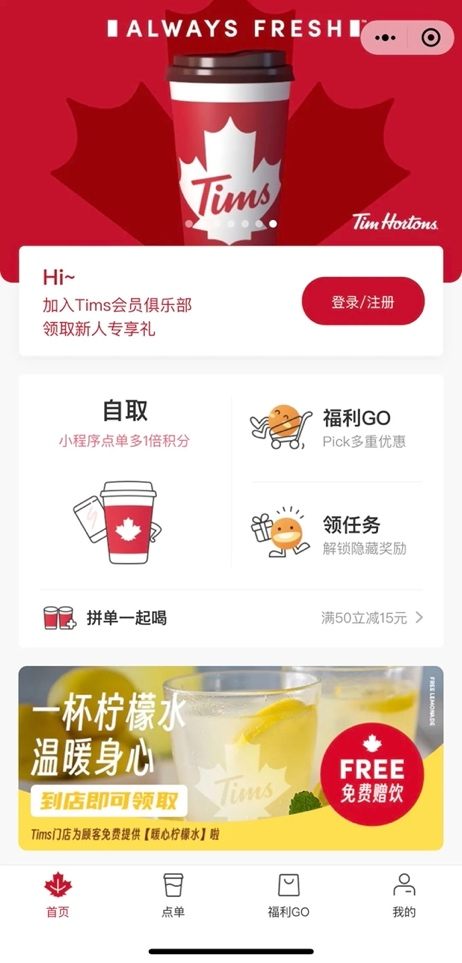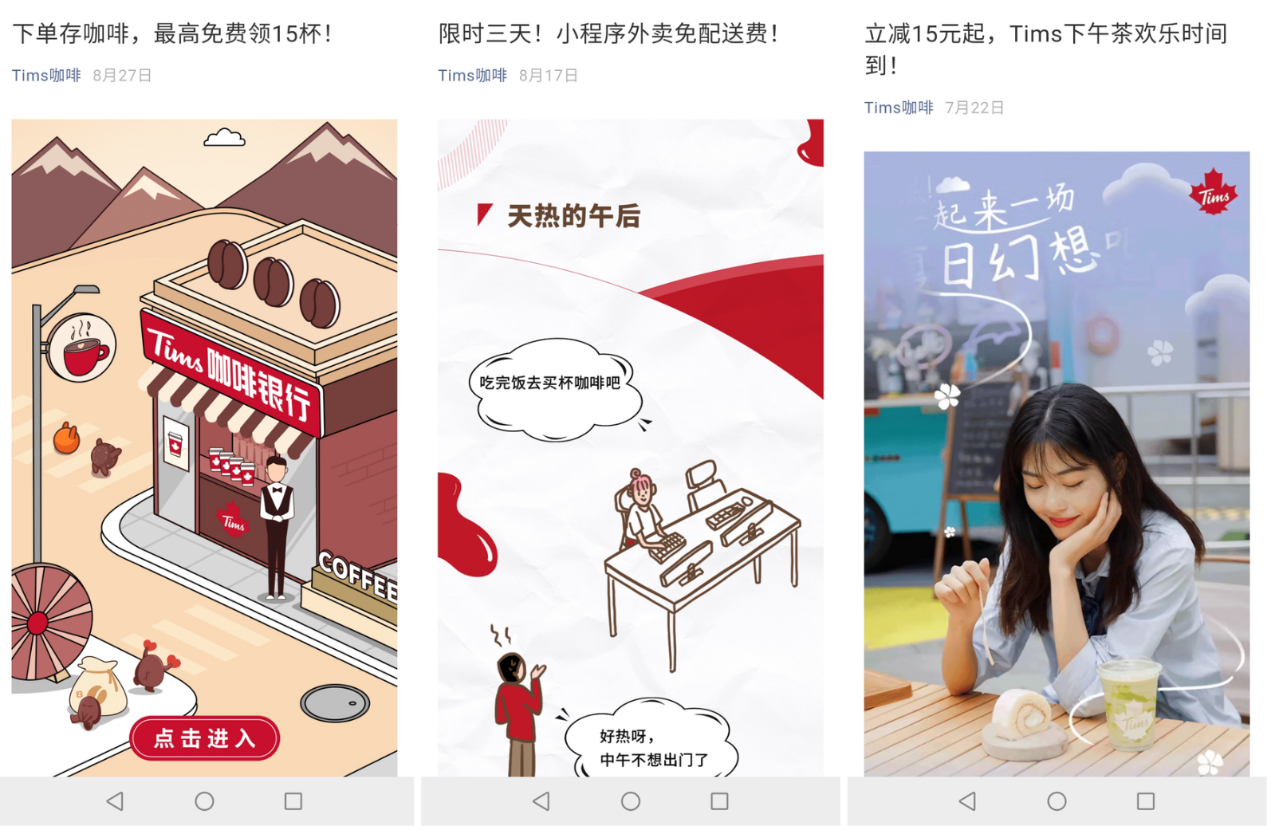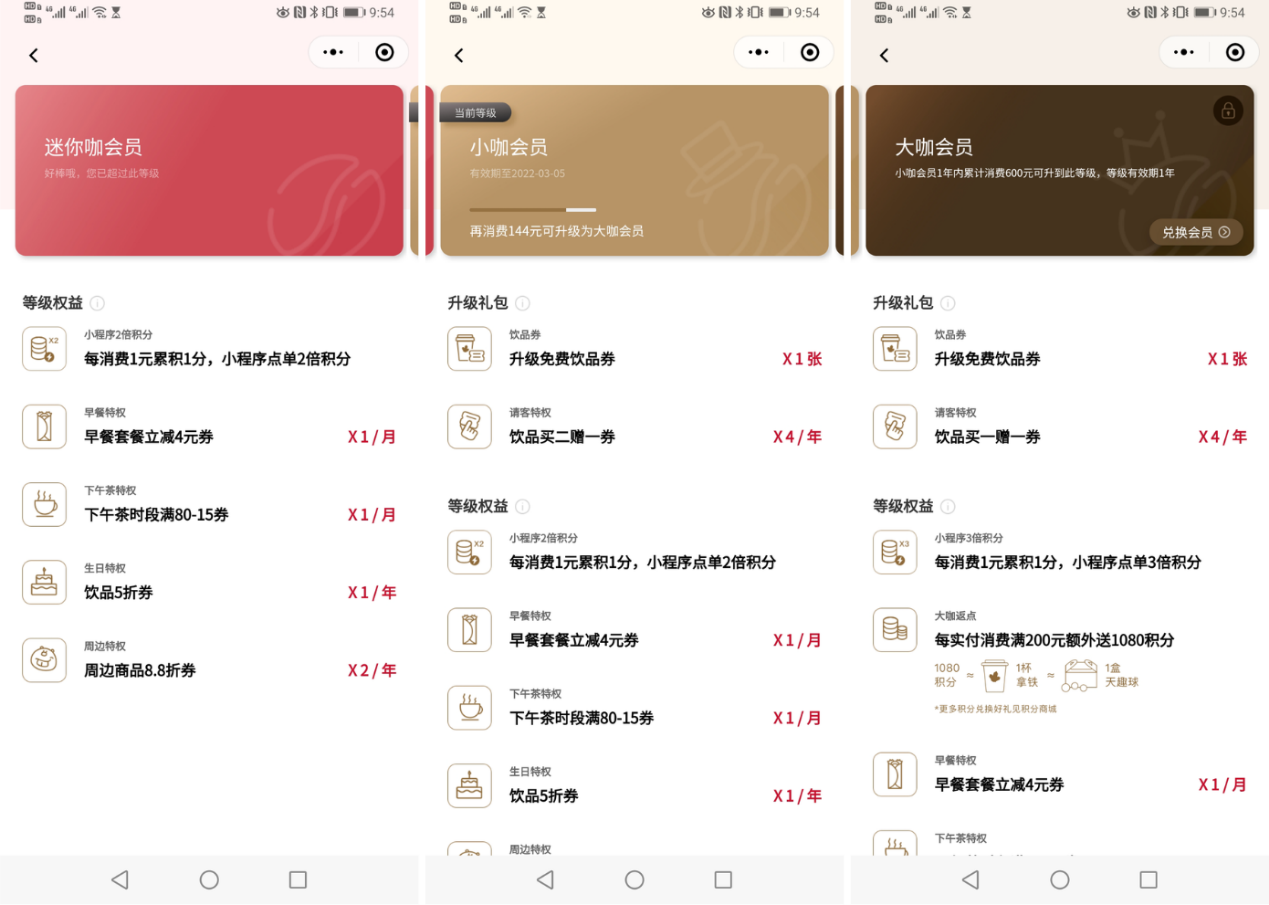案例亮点
通过搭建订单中心、小程序、会员体系和BI(商业智能)组成的数字化体系,Tims在交易营销端和门店管理端不断转型升级,真正做到“开源节流”,增强了品牌的抗风险能力。同时,Tims还依托小程序、企业微信社群等私域布局,打造品牌和会员之间的互动场,唤醒会员、提升活跃度。
企业概况
Tims Hortons有加拿大“国民咖啡”之称,也是全球两大最有价值的咖啡连锁品牌之一。在英国权威品牌评估机构 Brand Finance 发布的“全球最有价值的 25 个餐厅品牌”排行榜中,Tim Hortons 连续多年入围。
2019年,Tims天好咖啡登陆中国。凭借“咖啡+暖食”的特色组合,积极有效的本地化策略以及创新的社区化经营,Tims天好咖啡在中国市场快速发展。截至目前,Tims天好咖啡已完成中国市场的初步布局,在上海、北京、广州、深圳、重庆、成都、南京、杭州、福州、郑州等30多个城市开出超600家门店,其中在上海的门店数量超过200家。
需求痛点
随着烟火气逐渐回归,咖啡市场重回发展快车道。不过,产品同质化、行业竞争现象不断加剧,促使越来越多的市场参与者开始探索数字化转型以及精细化运营。同时,如何精准抓住年轻消费者的诉求、占领消费者心智,也成为各大咖啡品牌“留量”必须考虑的重要因素。
因此,Tims天好咖啡携手腾讯智慧零售,持续释放数字化运营红利,以精细化运营降本增效、增强品牌竞争力,并进一步增强用户粘性,寻找新的生意增量,实现流量和销量的双突破。
优秀实践
- 持续强化数字化升级,真正做到“开源节流”
2019年2月,Tims在上海开出了中国首店。
Tims来到中国之时,就开启数字化进程,搭建订单中心、小程序、会员体系和BI(商业智能),打通数据,实现BI可视化,完成了初步基建。消费者可以通过小程序线上点单,也可以参与“买一送一”的新店活动,实现了会员在线上的初步汇聚。

数字化建设的第二步,Tims重新打磨小程序,将会员体系进行优化,在小程序开启越来越多活动,同时做起了视频号,搭建起越来越多的社群,对会员做到更多触达。从聚焦基建到精细运营,品牌与会员的互动更加频繁,进一步加深了数字化程度。
2023年伊始,Tims天好咖啡门店突破600家,在门店规模越来越大的当下,Tims也开始搭建自己的交易营销中台,响应速度更快。
通过持续深化的数字化建设,Tims全方位“开源节流”,增强了品牌的抗风险能力。
在开源上,现在消费者一天70—80%的时间都在线上,线上成了生活、工作的主场。当线下顾客转变成线上会员后,Tims线上展开的活动与触达,消费者都能很便捷地参与其中,最大程度拉近了双方的距离。

售卖端,Tims通过数字化重塑交易链路,实现线上小程度点单,到店领取咖啡。整个过程更加便捷,消费者不用过多等待,体验感大幅提升。同时,线上点单积累的数据,也让品牌更大程度地了解消费者,他是谁,他有什么样的口味喜好、消费习惯;透过整个会员群体来看,是不是有健康的新趋势,是不是要推出一些低咖啡因的产品。会员大数据的加持,让Tims的产品决策更清晰,运营更精准。
产品需求外,Tims根据会员反馈,还会积极达成与其他品牌的合作,实现会员的心愿,不仅满足了他们的精神需求,也为未来发展构建了更加清晰的品牌内核。
可以看出,数字化让Tims跟消费者更加亲近,也使得品牌可以更好地服务消费者,有的放矢;另外,消费者也会用更高频的购买,给予积极的反馈,不断提升营业额,真正做到“广开源”。
在节流上,Tims依托系统化、数字化管理,更好地记录、追踪、优化,做到了运营效率更高,成本更省。在门店,智能排班、自动订货等流程,也通过数字化系统做到了优化。这样一来,当品牌爆发出规模效益,营业额不断提升,人力成本却没有大幅增加,大大增强了企业盈利的可能性。
开源与节流,作为企业运营不变的主题,无论是疫情时,还是非疫情时,都极为重要。Tims在数字化转型的进程中,不断创新,让这一主题落实地更彻底,开源上,在交易营销端,怎样跟用户亲近,更好地了解用户,服务用户,让企业赚到更多的钱;在节流上,用数字化改善管理,如门店端的管理,通过智能化设备、大数据算法来做改善。
- 小程序搭建完整会员路径,加速新品传播、裂变
从一开始,Tims就在微信搭建小程序,并将其视为数字化建设的重中之重。对于Tims来说,小程序不仅仅是线上门店,消费者可以线上点单,省时高效;也是品牌和会员之间的互动场,有很多营销活动来跟消费者互动;更是个服务场,方便品牌更好地服务用户。
另外,小程序也是Tims会员体系重要的载体。从“迷你咖”到“大咖会员”,小程序搭建了完整的会员路径,引导折扣权益、情感权益,并探索成就徽章、免排队等新权益,让会员的粘性越来越高。同时,会员体系也是会员个性化运营的重要依据。Tims针对不同的会员标签去做不同的营销动作,根据消费频率、消费喜好,推送不同的券包,响应用户需求,收到了更好的营销效果。

如今,Tims已经拥有了超过1100万的粉丝。这个巨大的私域流量,正成为品牌重要的发力点,特别是在产品上新这一提升活跃度的重要环节。
之前,Tims的新品只在上新当天重点宣传、推广。现在,Tims通过小程序,大大拉长了新品活动时间,宣传期从上新前3天就开始了,充足的预热周期,让新品有了口碑发酵的可能性。免费领取的新品买一送一券,向会员宣告新品的同时,更激励他们带着朋友来尝鲜,原本用于新品宣传的媒体投放,转化为会员福利,激发人际传播的链条。
新品上新的第三天,Tims则会推出新品券包,如2杯8折券,让体验过新品消费者再来品尝,增加消费频次,也会在社群中宣传券包,或成为社群中定时发送的新品福利。新品上新一段时间后,如果有过往消费频率不错,但还未尝新的会员,Tims还会赠送新品5折券,邀请他们来尝试新品,进一步扩大了新品的覆盖面。
Tims小程序这一围绕新品的持续打法,不仅拉新效果明显,新品渗透率也很高,新品大爆的几率大大增加。在成本层面,原本用于新品宣传的媒体投放转变为会员福利,成本节省了,会员的品牌好感度大幅提升。
私域持之以恒地运营,正积累成巨大的流量池,成为Tims重要的发力点,传播、裂变,都有了大体量的支撑。
- 社群精细化运营,全方位互动唤醒会员
随着私域更精细地运营,正逐渐聚焦到社群中。对于会员基数是千万级的品牌而言,如何唤醒会员,提升活跃度成了难题。
于是,在社群中广泛应用的企业微信,成了Tims行之有效的工具,无论是朋友圈、1对1消息的发送,还是在社群中推送消息,都能较快地唤醒用户,提升活跃度。社群成员的消费频次是普通会员消费频次的1.5倍,这对整体营收的提升有着巨大的贡献。
此外,品牌召集的年轻客群,不仅在社群中有较高的发声意愿,对新工具、新活动的接受程度更高。企业微信的接龙、裂变等功能,也能积极回应这种需求。
在未来的私域生态领域,Tims希望能通过更有效的运营,让更多的消费来自于会员体系,集中资源搭建好营销中台,有更好的载体和体系去服务好用户;会员体系再迭代,跟品牌的关联度更高,权益更细分,让用户更能感知到会员体系的价值感;和会员互动的后花园更丰富、更温暖。

数据成果
- 自2019年进入中国市场之后,Tims业务快速增长,并于2022年9月29日,通过“SPAC+PIPE”的组合模式赴美上市。上市后的首份季报显示,Tims实现总净收入3.06亿元,同比增长67.9%;经调整自营店EBITDA(税息折旧及摊销前利润)1940万元,同比增长336.6%;净新开门店46家。
- 目前,Tims已经拥有超过1100万的粉丝。同时,会员营收占比达70%,2021年底月会员复购率已近40%。